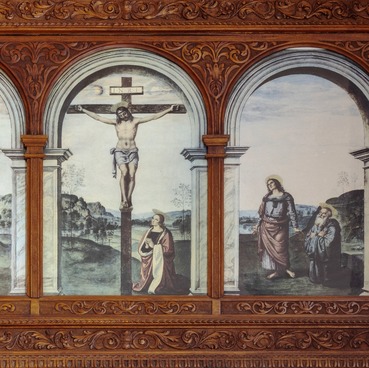The album “Memories of Crimea” from the collection of Livadia Palace provides a brilliant evidence of the Crimean resort boom of the last third of the 19th century. The album includes 27 views of cities and towns of the peninsula, made in the technique of engraving on steel. The album was created by a German artist and engraver Julius Berndt.
The engravings depict the most prominent places of Crimea: Simferopol, Bakhchysarai, the fortress of Chufut-Kale, Yevpatoria, Sevastopol, Balaklava, Yalta, Sudak, Feodosia, Kerch; St. George’s Convent and the Monastery of St. Stephan in Kiziltash. They also feature the Greek village of Autka, the settlements around Yalta — Alupka, Alushta and Oreanda, the palaces of the monarchs in Livadia, Gurzuf with Ayu-Dag Mountain, and the mountains of Koktebel. The texts accompanying each engraving describe the depicted places, their history, builders and owners. The pictures in the album have been the trademark of Crimea for many decades. The popular album and travel guide, first published in 1869, was later reprinted several times.
This album is bound in a hardcover of green linen with a gilded inscription “Memories of Crimea”, decorated with a floral design. The inscription is enclosed in a gilded frame, with ornamental flowers in the corners. On the spine is an inscription “Memories of Crimea” in a gilded frame with a foliage pattern. The edges of the binding are embossed. The flyleaves are of white moiré. The foretitle page features an inscription “Album of all the best views of Crimea: 27 engravings on steel with text”, which has an ornamental frame of interlacing vines with fruit and grasses interwoven in it. The frame encompasses three views of Crimea. Under it on the left is an inscription: “Edited by Emil Berndt”. On the right: “Leipzig. Engraving. Julius Berndt”. The title page has the following information in addition to the above: second edition and the year of publication 1883. The book block consists of 43 sheets and 27 engravings, the texts on the pages are bordered in red. Each article has an illustrated initial letter.
Emil Berndt, who created the album, was not only an artist, but also a publisher and bookseller, and chairman of the Odessa German Society “Harmony”, founded in 1861 to pursue educational goals.
The engravings depict the most prominent places of Crimea: Simferopol, Bakhchysarai, the fortress of Chufut-Kale, Yevpatoria, Sevastopol, Balaklava, Yalta, Sudak, Feodosia, Kerch; St. George’s Convent and the Monastery of St. Stephan in Kiziltash. They also feature the Greek village of Autka, the settlements around Yalta — Alupka, Alushta and Oreanda, the palaces of the monarchs in Livadia, Gurzuf with Ayu-Dag Mountain, and the mountains of Koktebel. The texts accompanying each engraving describe the depicted places, their history, builders and owners. The pictures in the album have been the trademark of Crimea for many decades. The popular album and travel guide, first published in 1869, was later reprinted several times.
This album is bound in a hardcover of green linen with a gilded inscription “Memories of Crimea”, decorated with a floral design. The inscription is enclosed in a gilded frame, with ornamental flowers in the corners. On the spine is an inscription “Memories of Crimea” in a gilded frame with a foliage pattern. The edges of the binding are embossed. The flyleaves are of white moiré. The foretitle page features an inscription “Album of all the best views of Crimea: 27 engravings on steel with text”, which has an ornamental frame of interlacing vines with fruit and grasses interwoven in it. The frame encompasses three views of Crimea. Under it on the left is an inscription: “Edited by Emil Berndt”. On the right: “Leipzig. Engraving. Julius Berndt”. The title page has the following information in addition to the above: second edition and the year of publication 1883. The book block consists of 43 sheets and 27 engravings, the texts on the pages are bordered in red. Each article has an illustrated initial letter.
Emil Berndt, who created the album, was not only an artist, but also a publisher and bookseller, and chairman of the Odessa German Society “Harmony”, founded in 1861 to pursue educational goals.


